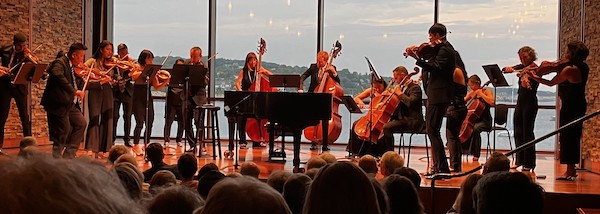Concert Review: A Far Cry — A Compelling Evening of Music about Homecoming
By Steve Provizer
Happily, the string orchestra A Far Cry has the skill to back up its good intentions with good music.

A glimpse of A Far Cry in action at the Shaolin Liu in Rockport. Photo: Steve Provizer
A Far Cry is a string orchestra, although it doesn’t specifically identify itself that way. Size matters when it comes to groups of this type, and A Far Cry has obviously given careful consideration to the aggregate of its membership. I don’t know the history of the ensemble. It may have begun with a large number of players, or it may have adjusted its size according to what the group chose as repertoire over the years. It’s presently composed of 18 members playing violin, viola, cello, and string bass. That assemblage was perfectly adapted to the wide range of pieces that it performed on July 5 at the Shaolin Liu in Rockport. The ensemble demonstrated the grit, variation in techniques, and dynamics necessary for a 21st century clarinet concerto as well as the legato, light touch, and sonic blending needed to effectively play a late 19th century piece by Leos Janacek.
There is a ”cooperative” ethos in the group. The chosen repertoire does not emphasize any particular player’s virtuosity. In fact, with each new piece played, the musicians moved around from first to second “chair” positions and vice versa, occasioning no drop off from the group’s high level of technical competence.
The performances all related to the theme of “Homecoming.” The first piece, Kareem Roustom’s “Dabke,” was a compelling blend of new “western” compositional techniques with rhythmic and melodic elements drawn from the Middle East. For me, it was the high point of the evening.
“Ibn Arabi Postlude” followed, a composition by guest clarinetist Kinan Azmeh. He introduced the performance, explaining that Ibn Arabi was a Muslim mystic and philosopher of the Middle Ages; a religious man who was also a free thinker. The piece began with an extended piano solo by guest pianist/composer Dinuk Wijeratne. I was not moved by this section; there was too much New Age rambling in it for me. The clarinet entered and set the tone for the rest of the composition, which was marked by insistent rhythms and Eastern scales. It alternated improvised and composed sections, a similar strategy to what was taken in the next composition, Dinuk Wijeratne’s “Clarinet Concerto”.
About the composition, the composer said : “This concerto is part autobiographical immigrant story, part response to the Syrian conflict and part exploration of the notion of ‘home.’” The piece is divided into 6 parts that follow the general theme as Wijeratne describes it. The clarinet begins offstage and it makes its entrance underneath some very nice writing for the strings. As the strings hold notes or ostinato figures, the clarinet improvises dynamically. The accent is on scalar and rhythmic variation and ornamentation. Azmeh is a strong soloist and locked in nicely with the orchestra, especially in Part 3, “Flux.” The composition ends with a dramatic string of high notes from the clarinet.
The second half of the program was Leoš Janáček’s “Idyla (Idyll”), written in 1878. Janáček’s life straddled two centuries (1854-1928). His music changed a great deal with the arrival of the new century. In 1878, his writing was very similar to that of his elder, Antonín Dvořák, whom he had befriended not long before he wrote “Idyla.” This pleasing piece, made up of seven parts, is lightly inspired by with the folk traditions of Moldavia-Czechoslovakia. At this point in music history, Brahms, Fauré, Richard Strauss, Busoni, and others were at various challenging stages in their careers. Janáček was yet to become adventurous: “Idyla” is not boundary-pushing. Folk colorations and rhythms play pleasingly within a harmonic framework that’s in flux. A Far Cry played the piece with confidence, exuding a strong understanding of the composer’s intentions.
As noted, “Homecoming” was the theme of the evening. Reviewing is largely a subjective process, no more so than when attempting to evaluate whether music that is meant to be tied to a specific theme — i.e. “program music” — succeeds. To be honest, I should be counted as somewhat of a program music skeptic. The music and performances may be wonderful, but whether or not I see fawns in “Afternoon of a Fawn” or trees in “The Pines Of Rome” is something else. I suppose that, if cannons are shot off during the rendition of a composition, war looms as the obvious subtext. The homecoming theme was referred to throughout the performance — this was a smart strategy because it kept the titular theme in the minds of the listeners. In any case, it’s a timely topic whose intrinsic emotional weight is undeniable.
The passion A Far Cry brings into exploring creative programming — as well as its non-hierarchical and seemingly non-sexist approach — are to be commended. Happily, they have the skill to back up their good intentions with good music.
Steve Provizer writes on a range of subjects, most often the arts. He is a musician and blogs about jazz here.
